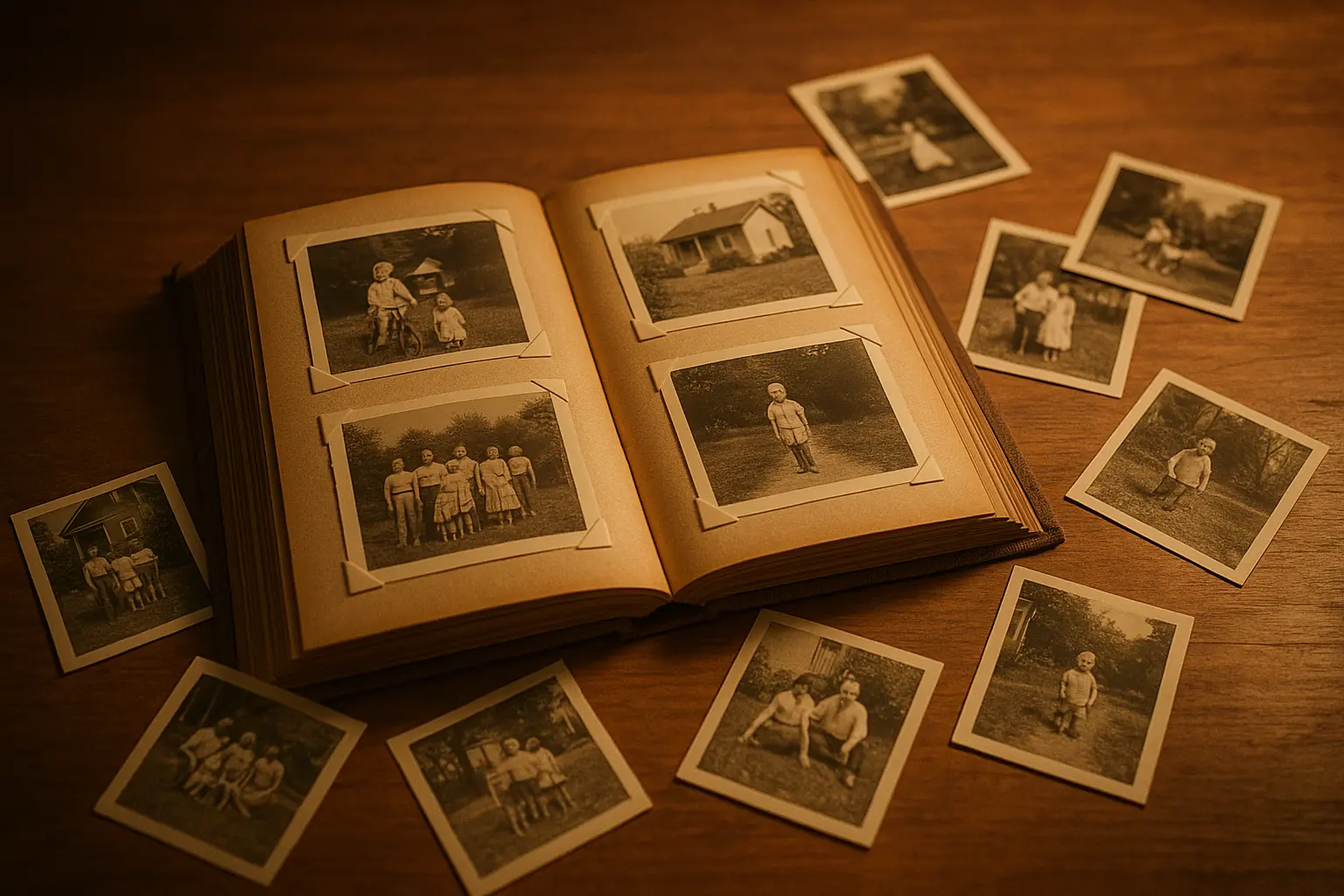The phone call came at 2:47 AM.
You know the one I’m talking about – the call that splits your life into “before” and “after.” One minute you’re sleeping peacefully, and the next, someone you love is gone. No warning. No goodbye. No time to prepare.
Quick Resource:
When grief and shock make words impossible, our Funeral Speech Generator helps you craft a compassionate, grounded tribute that honors your loved one with clarity and care.
Now you’re supposed to write a eulogy. Stand up in front of everyone and find beautiful words when you can barely remember your own name. Your brain feels like it’s wrapped in cotton, but somehow you need to capture an entire life in a few minutes of speech.
Find your footing with the Funeral Speech Generator — designed to help when grief clouds your thoughts.
I’ve been there. I’ve watched families stumble through this exact nightmare more times than I can count. And here’s what I wish someone had told me when I was in your shoes: You don’t need perfect words. You just need real ones.
Writing a eulogy is never easy, especially when the loss is sudden. The shock can make it difficult to gather your thoughts, let alone find the words to honor a loved one’s memory from Eulogy Generator’s comprehensive guide on sudden loss eulogies.
Why Unexpected Death Hits Different
When someone dies suddenly, grief doesn’t follow the usual rules. There’s no gradual decline to mentally prepare for, no final conversations to treasure, no chance to say goodbye. Instead, you’re dealing with shock that makes your brain work differently.
That numbness you’re feeling? That’s not weakness – that’s trauma. Your mind is trying to protect you from a reality that’s too big to process all at once. The problem is, this same protective mechanism makes it nearly impossible to access the happy memories you need for a eulogy.
I remember sitting with Maria, whose 22-year-old son died in a motorcycle accident. She kept saying, “I can’t remember anything good right now. All I see is that phone call.” Her brain had essentially locked away the joy to shield her from more pain.
When memories feel distant, let the Funeral Speech Generator guide you toward stories that heal.

When Your Brain Just Won’t Cooperate
Your brain literally stops cooperating. The part that usually helps you organize thoughts and remember things just… shuts down. It’s like trying to write a love letter while someone’s screaming in your ear.
This isn’t your fault, and it’s not permanent. Your prefrontal cortex – the thinking and organizing part of your brain – goes offline during trauma while your amygdala fires on all cylinders, keeping you in survival mode. This biological response makes it nearly impossible to do the reflective thinking that eulogy writing typically requires.
The first time I had to write a eulogy for someone who died suddenly, I threw away seven drafts. Each one felt like I was trying to solve a math problem instead of honoring someone I loved. Finally, my sister said, “Just tell us who he was.” That’s when it clicked – I didn’t need to explain anything. I just needed to remember out loud.
Finding Light When Everything Feels Dark
The intensity of grief can completely overshadow positive memories, making it feel impossible to celebrate life when you’re drowning in trauma. Sometimes you need permission to laugh during this process. I’ve seen families feel guilty for smiling while writing a eulogy, as if joy somehow dishonors their grief.
The truth is, your loved one would want you to remember the good times, especially now. You’re not betraying them by finding moments of lightness in their story.
Honor both the pain and the light with the Funeral Speech Generator.
Simple Approaches That Actually Work
When you’re staring at a blank page with hours until the service, forget everything you think you know about “proper” eulogy structure. Here are approaches that work when your world has just been turned upside down:
The “Life Interrupted” Method: Start by acknowledging the elephant in the room – yes, this feels too soon, but look at everything they packed into their time here. A mother writing for her 25-year-old son killed in a car accident might say: “While Jake’s 25 years feel impossibly short to those of us left behind, in that time he managed to graduate college, start his dream career, fall deeply in love with Sarah, and touch countless lives through his volunteer work at the animal shelter.”
Memory Snapshots: Don’t worry about connecting stories perfectly. Sometimes a collection of vivid moments paints the best picture. Start with childhood, move through school years, then adult relationships and achievements. Each memory doesn’t need to flow into the next – the variety itself tells the story of a full life.
Present Tense Storytelling: Make them feel alive during the service by using present tense. Instead of “Sarah was always the first to help,” try “Sarah is the person who shows up with soup when you’re sick and stays to do your dishes.” It makes them feel less gone, at least for those few minutes.
When crafting a eulogy for sudden loss, understanding the fundamental principles of eulogy writing provides a foundation that can be adapted to these unique circumstances.

Dealing with Questions That Have No Answers
Everyone in that room is asking “why now?” and “what if?” You can’t answer those questions because they don’t have answers. What you can do is acknowledge that we’re all asking them.
“I don’t know why this happened. I don’t know why someone so young, so full of life, so loved by so many people is gone. What I do know is how much joy Michael brought to everyone who knew him, and how that joy doesn’t disappear just because he’s not here to create more of it.”
It’s okay to say “I don’t know why” during a eulogy. Sometimes honesty about the senselessness provides more comfort than trying to force meaning onto tragedy.
Writing When You’re Running on Fumes
The reality of unexpected death is that you don’t get the luxury of time. You’re dealing with funeral arrangements, family logistics, and your own grief while facing an immediate deadline. The good news? Heartfelt doesn’t require perfect.
Emergency Strategies That Work
The 24-Hour Method: Start with phone calls to everyone who knew them well. Ask each person for their favorite memory and what they’ll miss most. Don’t worry about organizing yet – just collect. Look for patterns in what people shared – were they always the funny one? The helper? The dreamer? These patterns become your themes. Then write in 30-minute chunks with 15-minute breaks for crying, calling friends, or just staring at the wall.
Getting Everyone Involved: Give your sister the high school years, your mom the childhood stories, their best friend the college memories, and their spouse the recent adventures. Each person becomes responsible for one section, then you combine everything into a unified tribute.
Professional eulogy templates can provide crucial structure when time is limited and emotions are overwhelming your ability to organize thoughts effectively.
Managing Your Emotions While Writing
Your emotions aren’t the enemy here – they’re actually the fuel for creating something meaningful. The trick is learning to work with them in manageable doses.
Build intentional pauses into your writing process. Set a timer for 30-minute writing sessions followed by 15-minute grief breaks where you can cry, scream, or just sit quietly. During your grief breaks, do whatever feels right. Punch a pillow, call your best friend, take a hot shower, or just stare at the wall.
Keep a trusted friend or family member present during writing sessions. Choose someone who knew your loved one well enough to contribute memories but isn’t so devastated that they can’t function. You need someone who can hand you tissues, make you coffee, and gently redirect you when you get stuck in painful loops.

Getting Through the Speech Without Falling Apart
Standing up there with everyone’s eyes on you while your heart is breaking feels impossible. I’ve watched people freeze completely, others break down sobbing, and some power through with sheer determination. All of these responses are normal, and all can still result in meaningful tributes if you prepare properly.
Preparing for the Emotional Tsunami
Read your eulogy out loud at least five times before the service. Your mouth needs to know where it’s going even when your brain shuts down from emotion. Mark the spots where you know you’ll struggle and plan your recovery strategy for each one.
Always designate a trusted family member or friend who can step in if emotions become too overwhelming. Brief them thoroughly – they should know which parts are most important to you and how you want them to handle the transition if they need to take over. This isn’t admitting defeat; it’s smart planning.
Before you start speaking, take three deep breaths that fill your belly, not your chest. If you feel yourself losing control during the speech, pause and breathe again. The audience will wait – they understand what you’re going through.
Speaking to an Audience in Shock
Whether delivering an eulogy for dad or another loved one, remember that sudden death often creates larger, more diverse audiences as communities rally around grieving families. You’re speaking to people processing the loss at different rates.
Address the collective disbelief right up front: “I know we’re all still trying to wrap our heads around this. Yesterday morning, everything was normal, and now we’re here. It doesn’t feel real, and maybe it never will completely.”
Speak to the person who’s still expecting their phone to ring, the person who’s furious at the unfairness, and the person who’s already trying to find meaning in the loss. Your words need to hold space for all these experiences simultaneously.

The Hard Conversations Nobody Prepares You For
Some sudden deaths come with additional complications that make eulogy writing even more challenging. These are the situations where well-meaning people offer platitudes that feel hollow, where family members disagree about what should be said, and where the circumstances threaten to overshadow the celebration of life.
When Dreams Won’t Be Fulfilled
The graduation that won’t happen, the wedding that was being planned, the business they were going to start – these absent futures can feel more painful than the present loss. Your eulogy needs to acknowledge these dreams without making them the focus of grief.
Turn potential into inspiration: “Mark always talked about opening a restaurant that would hire people getting back on their feet – ex-offenders, people in recovery, anyone who needed a second chance. While he won’t get to open those doors himself, I know his vision will inspire others to create those opportunities in their own communities.”
Celebrate the journey, not just the destination. Focus on the steps they took, the people they influenced along the way, and the passion they brought to their pursuits. The journey itself had value, even without reaching the final destination.
Tell the full story — not just the ending — with help from the Funeral Speech Generator.

When Circumstances Are Complicated
Suicide: Address mental health struggles honestly while emphasizing the person’s humanity and positive contributions. Focus on their battle with illness rather than their method of death. Mental illness is a disease, just like cancer or heart disease. You wouldn’t blame someone for dying of cancer, and you don’t need to blame someone for dying of depression.
“While Michael fought a battle with depression that ultimately took his life, we remember him for his incredible kindness to younger students, his talent for making people laugh, and his deep love for his family. His struggle with mental illness doesn’t define him – his compassion and the joy he brought to others does.”
Substance-Related Deaths: Address addiction honestly as a disease while emphasizing your loved one’s humanity beyond their struggles. “Sarah’s addiction was a disease that she fought courageously for years. But Sarah was so much more than her addiction. She was the person who remembered everyone’s birthday, who could make you laugh when you were having the worst day, who volunteered at the animal shelter every weekend.”
Violence: Keep the focus entirely on the life that was lived and the love that was shared. Don’t give the violence more power by making it the center of your tribute. The person who committed the violence doesn’t deserve space in your loved one’s eulogy.
Faith, Questions, and Different Beliefs
“I know many of us are struggling with our faith right now, wondering how this could be part of any plan. I don’t have answers to those questions. What I do know is that the love we shared with Jennifer, and the love she shared with us, is real and lasting and good.”
When speaking to diverse audiences, focus on universal themes of love, memory, and human connection that transcend specific religious doctrines. Talk about how love continues beyond physical presence, how memories keep people alive in our hearts, and how the impact of a good life ripples through generations.

Different Types of Sudden Death, Different Approaches
Accidents That Steal Someone Full of Life
The randomness of accidents makes them particularly hard to process. Focus intensely on your loved one’s vitality and future plans to counterbalance the tragic nature of their death. Whether you’re crafting an eulogy for dad who was taken in an accident or honoring another family member, emphasizing their active engagement with life provides comfort.
For a college student killed in a hiking accident: “Emma had just changed her major to environmental science because she wanted to ‘save the world’s forests,’ as she put it. Her planner was full of hiking trails she wanted to conquer, friends she wanted to visit, and dreams she was actively pursuing.”
Medical Emergencies That Came Out of Nowhere
Heart attacks, strokes, and other sudden medical events carry their own burden of “what if” questions. Focus on how they lived courageously and fully rather than medical details that don’t serve the celebration of life.
“Dad spent his last morning doing exactly what he loved – working in his garden, calling to check on his grandkids, and planning next weekend’s barbecue. He was living his life fully right up until the end.”
When Young Lives End Too Soon
Young deaths often require drawing from short eulogy examples that capture a life’s essence quickly. Present unfulfilled goals as inspirational challenges for others rather than tragic losses.
“Jessica always talked about becoming a teacher because she wanted to make learning fun for kids who struggled in school. While she won’t get to have her own classroom, I know there are people in this room who will remember her passion for helping others learn.”

Getting Support and Giving It
The unique trauma of unexpected death affects entire families and communities . Understanding how to provide and access appropriate support can make the difference between a family that struggles alone and one that successfully honors their loved one while beginning to heal.
Professional Resources That Help
Sometimes you need more than family and friends can provide. Grief counselors can help you understand why certain memories feel blocked and how to work through trauma responses interfering with your ability to write. The best funeral directors have connections to grief counselors, professional writers, and support groups specifically designed for these situations.
Professional funeral speech examples can provide inspiration and structure when you’re struggling to organize thoughts during this difficult time.
Creating Something That Lasts
Record yourself reading the eulogy, even if it’s just on your phone. Six months from now, when the shock has worn off and you’re missing their voice, you’ll want to hear those words again. Create copies for family members who couldn’t attend, and consider posting it on a memorial website where friends can access it.
The stories you tell in the eulogy become the family’s official narrative about your loved one’s life. These stories will be retold at family gatherings, shared with future grandchildren, and referenced during difficult moments when you need to remember the good times.
Preserve your loved one’s story with compassion using the Funeral Speech Generator.

When You Need Professional Help
Sometimes the combination of time pressure, emotional overwhelm, and unique challenges makes it impossible to create a meaningful eulogy on your own. There’s no shame in needing help. If you can’t string two sentences together without breaking down, if you’re facing a deadline in hours rather than days, or if the circumstances are particularly traumatic, professional support might be exactly what your family needs.

You Don’t Need Perfect Words
Writing a eulogy for unexpected death isn’t about finding perfect words or making sense of senseless tragedy. It’s about honoring a life that was cut short while acknowledging the very real shock and pain that sudden death creates.
Whether you’re writing an eulogy using proven examples or starting from scratch, remember that authenticity matters more than perfection when honoring someone taken too soon.
The most important thing I’ve learned about these impossible situations is that your loved one’s life deserves to be honored, even when you’re struggling to find words through your grief. Whether you write it yourself, get help from family and friends, or use professional tools and services, what matters is that their story gets told with love and respect.
Six months from now, you’ll read the eulogy you wrote in these impossible circumstances, and you’ll be amazed at what you created while your heart was breaking. Those words – imperfect, tear-stained, written in the middle of the worst week of your life – will become one of your most treasured possessions.
Your person’s story deserves to be told. And you’re exactly the right person to tell it, even when everything feels impossible. Especially then.
Remember that you’re not alone in this process. Sudden death affects entire communities, and there are people and resources available to help you create a meaningful tribute. Your loved one’s life had meaning and impact that deserves to be celebrated, regardless of how their story ended.
The phone call that changed everything can’t be undone. But the words you speak in their honor – those will echo in the hearts of everyone who loved them for years to come. And that’s something worth fighting through the fog of grief to create.
When you’re ready to begin, the Funeral Speech Generator will help you turn heartbreak into a lasting tribute.

